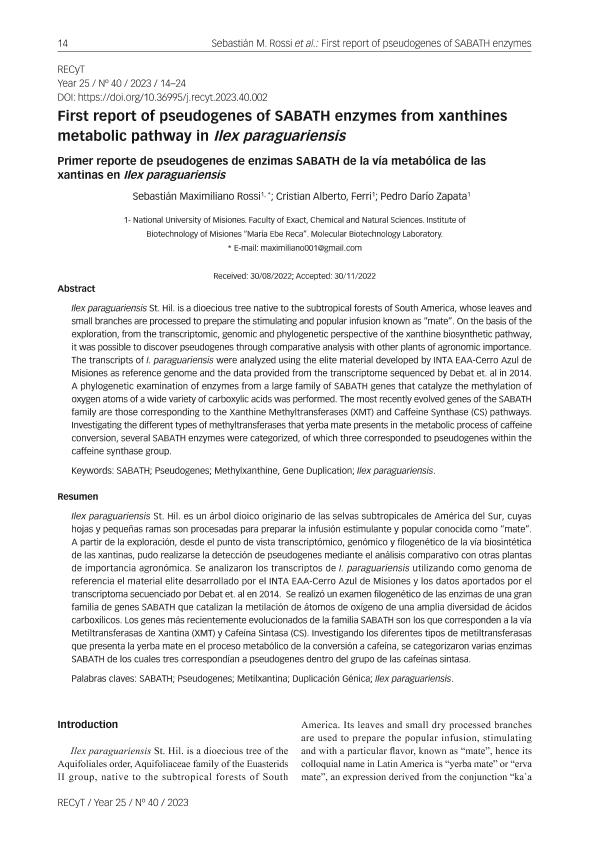Mostrar el registro sencillo del ítem
dc.contributor.author
Rossi, Sebastián Maximiliano

dc.contributor.author
Ferri, Cristian Alberto

dc.contributor.author
Zapata, Pedro Dario

dc.date.available
2024-01-24T15:13:00Z
dc.date.issued
2023-12
dc.identifier.citation
Rossi, Sebastián Maximiliano; Ferri, Cristian Alberto; Zapata, Pedro Dario; First report of pseudogenes of SABATH enzymes from xanthinesmetabolic pathway in Ilex paraguariensis; Universidad Nacional de Misiones. Facultad de Ciencias Exactas, Químicas y Naturales. Centro de Investigación y Desarrollo Tecnológico; Revista de Ciencia y Tecnología; 40; 1; 12-2023; 14-24
dc.identifier.issn
0329-8922
dc.identifier.uri
http://hdl.handle.net/11336/224710
dc.description.abstract
Ilex paraguariensis St. Hil. is a dioecious tree native to the subtropical forests of South America, whose leaves and small branches are processed to prepare the stimulating and popular infusion known as “mate”. On the basis of the exploration, from the transcriptomic, genomic and phylogenetic perspective of the xanthine biosynthetic pathway, it was possible to discover pseudogenes through comparative analysis with other plants of agronomic importance. The transcripts of I. paraguariensis were analyzed using the elite material developed by INTA EAA-Cerro Azul de Misiones as reference genome and the data provided from the transcriptome sequenced by Debat et. al in 2014. A phylogenetic examination of enzymes from a large family of SABATH genes that catalyze the methylation of oxygen atoms of a wide variety of carboxylic acids was performed. The most recently evolved genes of the SABATH family are those corresponding to the Xanthine Methyltransferases (XMT) and Caffeine Synthase (CS) pathways. Investigating the different types of methyltransferases that yerba mate presents in the metabolic process of caffeine conversion, several SABATH enzymes were categorized, of which three corresponded to pseudogenes within the caffeine synthase group.
dc.description.abstract
Ilex paraguariensis St. Hil. is a dioecious tree native to the subtropical forests of South America, whose leaves and small branches are processed to prepare the stimulating and popular infusion known as “mate”. On the basis of the exploration, from the transcriptomic, genomic and phylogenetic perspective of the xanthine biosynthetic pathway, it was possible to discover pseudogenes through comparative analysis with other plants of agronomic importance. The transcripts of I. paraguariensis were analyzed using the elite material developed by INTA EAA-Cerro Azul de Misiones as reference genome and the data provided from the transcriptome sequenced by Debat et. al in 2014. A phylogenetic examination of enzymes from a large family of SABATH genes that catalyze the methylation of oxygen atoms of a wide variety of carboxylic acids was performed. The most recently evolved genes of the SABATH family are those corresponding to the Xanthine Methyltransferases (XMT) and Caffeine Synthase (CS) pathways. Investigating the different types of methyltransferases that yerba mate presents in the metabolic process of caffeine conversion, several SABA
dc.format
application/pdf
dc.language.iso
spa
dc.publisher
Universidad Nacional de Misiones. Facultad de Ciencias Exactas, Químicas y Naturales. Centro de Investigación y Desarrollo Tecnológico

dc.rights
info:eu-repo/semantics/openAccess
dc.rights.uri
https://creativecommons.org/licenses/by-nc/2.5/ar/
dc.subject
ENZIMES
dc.subject
YERBA MATE
dc.subject
SABATH
dc.subject.classification
Otras Biotecnología Agropecuaria

dc.subject.classification
Biotecnología Agropecuaria

dc.subject.classification
CIENCIAS AGRÍCOLAS

dc.title
First report of pseudogenes of SABATH enzymes from xanthinesmetabolic pathway in Ilex paraguariensis
dc.title
Primer reporte de pseudogenes de enzimas SABATH de la vía metabólica de las xantinas en Ilex paraguariensis
dc.type
info:eu-repo/semantics/article
dc.type
info:ar-repo/semantics/artículo
dc.type
info:eu-repo/semantics/publishedVersion
dc.date.updated
2024-01-22T12:25:55Z
dc.identifier.eissn
1851-7587
dc.journal.volume
40
dc.journal.number
1
dc.journal.pagination
14-24
dc.journal.pais
Argentina

dc.description.fil
Fil: Rossi, Sebastián Maximiliano. Consejo Nacional de Investigaciones Científicas y Técnicas. Centro Científico Tecnológico Conicet - Nordeste; Argentina. Universidad Nacional de Misiones. Facultad de Ciencias Exactas Químicas y Naturales. Departamento de Bioquímica Clínica. Laboratorio de Biotecnología Molecular; Argentina
dc.description.fil
Fil: Ferri, Cristian Alberto. Universidad Nacional de Misiones. Facultad de Ciencias Exactas Químicas y Naturales. Departamento de Bioquímica Clínica. Laboratorio de Biotecnología Molecular; Argentina. Consejo Nacional de Investigaciones Científicas y Técnicas. Centro Científico Tecnológico Conicet - Nordeste; Argentina
dc.description.fil
Fil: Zapata, Pedro Dario. Universidad Nacional de Misiones. Facultad de Ciencias Exactas Químicas y Naturales. Departamento de Bioquímica Clínica. Laboratorio de Biotecnología Molecular; Argentina. Consejo Nacional de Investigaciones Científicas y Técnicas. Centro Científico Tecnológico Conicet - Nordeste; Argentina
dc.journal.title
Revista de Ciencia y Tecnología

dc.relation.alternativeid
info:eu-repo/semantics/altIdentifier/url/https://www.fceqyn.unam.edu.ar/recyt/index.php/recyt/article/view/764
dc.relation.alternativeid
info:eu-repo/semantics/altIdentifier/doi/http://dx.doi.org/10.36995/j.recyt.2023.40.002
Archivos asociados
